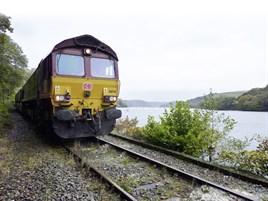“I think the majority of drivers’ concern is that the only thing that will not make it start is low batteries. It will start itself again. I could drop all the air, but the batteries could be good and it could run away. But, as drivers, we should scotch the locomotive anyway. So that should not be an issue.”
Today’s load is 1,835 tonnes (including 66176), so the train is 1,708t for a payload. The conditions are wet, and slippery uphill. Hancock started work this morning at 0430 at Fowey, and will finish at 1530. He has taken 66176 to Goonbarrow, Fowey, and will return it to St Blazey.
He has seen it all in Cornwall, and remembers the ‘Clay Hoods’. Recalling the introduction of the CDAs, and their subsequent use, he says: “When we started with ‘66s’ we had 24 on a train in a set, then it was 30, and now it is 38.”
As our train pounds along the Cornish Main Line, it noticeably slows. The cab environment is loud as the engine roars behind us, and yet the speedometer is dropping… 21mph… 17mph.
This is because the ‘66’ is climbing towards Trevarrin Tunnel, up a hill that twists and turns. It enters the tunnel at 12mph. XXx says it was a good climb, and that he has ground to a halt on the line several times. From the tunnel, it is downhill to Lostwithiel.
“I get half an hour to run round at Lostwithiel. It will shut down. We complained because it used to shut down after five minutes, but it is ten now.” He praises DB for listening to its drivers’ concerns.
Hutchinson chips in: “We leave it on at weekends. That uses fuel. We may ask what the point is, but it is looking at the system and will help with fuel and batteries.”
At Lostwithiel, the loop is the final part of an extensive railway system that is still used. It is adjacent to the Up line beyond the station, and next to former milk sidings that still have rails in them, although they are not connected to the main line.
Once the ‘66’ runs round its train, it couples on, and after an air-brake test we wait. An FGW Class 153 bound for Newquay passes, and then the ‘66’ shuts itself off.
There is an alarm to warn that this will happen, and a small light flashes in the cab. Hancock restarts it when needed, and 66176 fires up first time. “It probably has a better charge now than earlier,” he notes.
As we set off, he exchanges tokens with the signaller at Lostwithiel and descends onto the Fowey branch. This single-track line hugs the River Fowey all the way, and is stunning. The valley opens up in front of the train as it passes tree-lined river banks. The maximum speed is 30mph.
“I think at times people would pay for this view. It is such a pretty branch, and to think I am getting paid to see this,” he says.
The clay being transported today is largely bound for the Mediterranean and Egypt, for use in ceramics.
As the train approaches Fowey there is a pink building hidden away on the right. This is Sawmills Studio, where big-name musicians stash themselves away to record music. Hutchinson recalls the Gallagher brothers (from Oasis) being here.
Just beyond that is the entrance to Fowey Docks, and a weighbridge that the train passes over at between 0mph and 5mph. The wagons are unlocked as they pass over the weighbridge. This is air-operated. The arm comes out and unlocks the wagon by moving a catch. All 38 wagons are weighed in.
Once that is complete, the rake is split into two sets of 19. The first 19 are shunted into the unloading area, while the ‘66’ moves off to collect the second half, which it then backs onto the first half, so that all 38 pass through the unloading bay. One wagon will be left ready for the next train. There is already a wagon here from the last train.
There are two barrier wagons here. These are withdrawn CDAs, and have no brakes. When the ‘66’ pushes the wagons into the unloading facility, it uses the barrier to do so.
The wagons are then collected by the automatic loading facility (the Beetle), which moves them along like a conveyor belt. When a wagon is unloaded it is moved by gravity to the end of the siding, where it lands on a traverser. This then moves it across to the next siding, where the Beetle then moves it back into a siding.
A DB shunter then couples the wagons, and the ‘66’ can take them to their next destination. The rear wagon of today’s train will be left to become the front wagon of tomorrow’s train.
RAIL leaves the trains here and returns to Par, using the former Great Western branch that closed in 1968 and which is now a private road for Imerys. It passes the disused but intact railway station in the town. The road enters Par at the harbour, and soon RAIL is back at St Blazey.
With the Railhead Treatment Train at the depot, this means there are three locomotives on site. It’s almost like the old days.
Those days may never return, but the level of interest is still there. Cornwall remains a fascinating place for freight and innovation.
- This feature was published in RAIL 761 on 12 November 2014















Login to comment
Comments
No comments have been made yet.